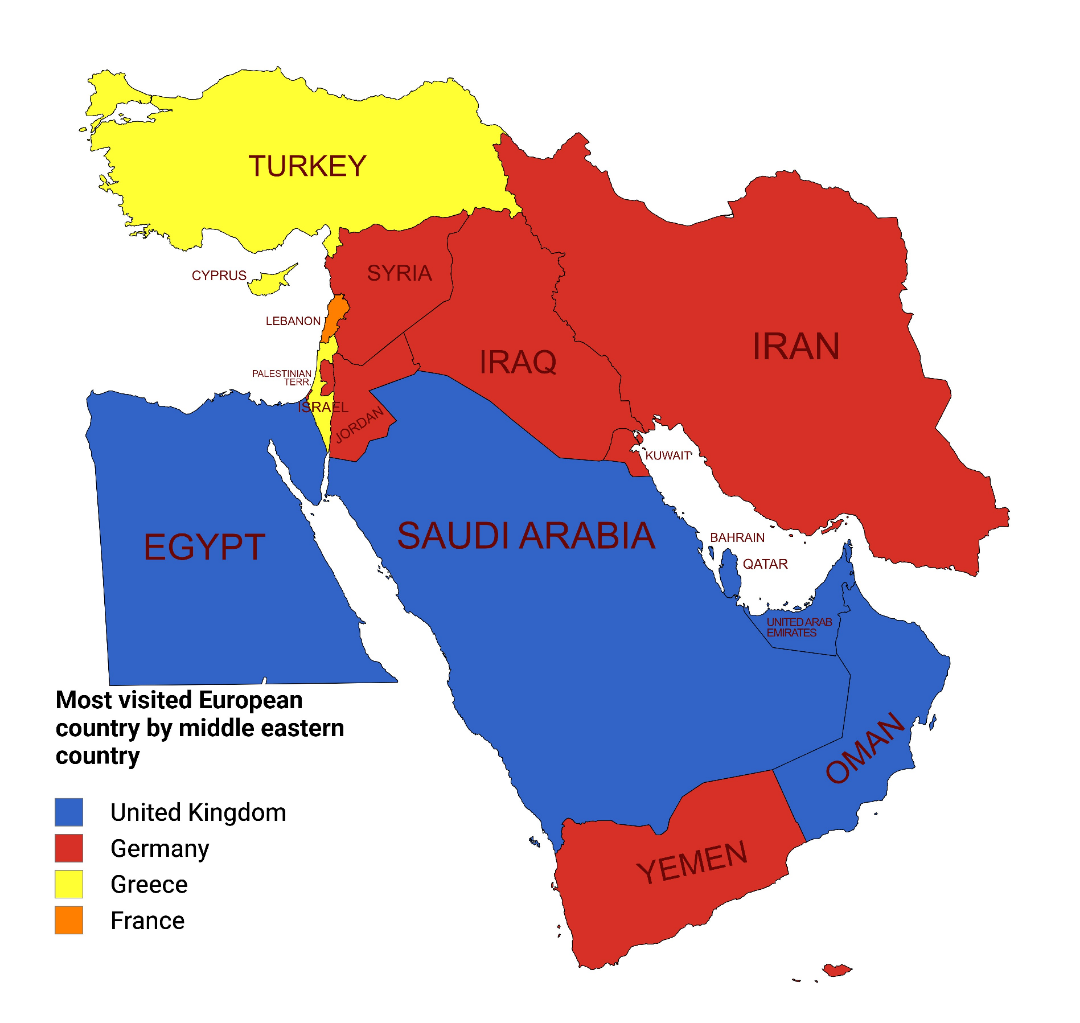Most Visited European Countries by Middle Eastern Tourists Map


Marcus Rodriguez
Historical Geography Expert
Marcus Rodriguez specializes in historical cartography and geographic data analysis. With a background in both history and geography, he brings unique...
Geographic Analysis
What This Map Shows
This map illustrates the European countries that attract the most visitors from the Middle East. It provides a visual representation of travel patterns and preferences, highlighting which destinations are favored among Middle Eastern travelers. By analyzing this data, we can gain insights into cultural, geographical, and economic factors that make these countries appealing.
Deep Dive into Middle Eastern Tourism in Europe
Tourism is a significant industry in Europe, with millions of travelers from all over the world flocking to its diverse countries. Interestingly, Middle Eastern tourists have shown a growing interest in European destinations. This trend is driven by several factors, including historical ties, cultural similarities, luxury travel options, and a desire for leisure and shopping experiences.
One of the most popular countries for Middle Eastern visitors is Turkey. With its unique blend of Eastern and Western cultures, Turkey offers stunning landscapes, rich history, and vibrant cities like Istanbul, which serve as a bridge between continents. The country's historic sites, such as the Hagia Sophia and Topkapi Palace, attract many tourists eager to explore its Ottoman heritage. Moreover, Turkey’s beautiful coastline along the Aegean and Mediterranean Seas provides an appealing summer getaway for Middle Eastern families.
Another significant destination is the United Kingdom, particularly London. The UK’s diverse cultural scene, luxury shopping districts, and educational institutions draw a considerable number of Middle Eastern tourists. Notably, the city’s famous Oxford Street, Harrods, and the West End theaters are hotspots for visitors looking to indulge in shopping and entertainment. Additionally, many Middle Eastern students pursue higher education in the UK, creating a connection that brings families and friends to visit.
France, with its iconic landmarks like the Eiffel Tower and Louvre Museum, also ranks high on the list. Paris is known as a fashion capital, appealing to Middle Eastern shoppers seeking high-end brands. The city’s gastronomy, art, and culture further enhance its allure. Interestingly, many Middle Eastern visitors prefer to stay in luxurious accommodations, such as five-star hotels and high-end resorts, which cater to their preferences for comfort and exclusivity.
Germany, particularly cities like Berlin and Munich, has also seen an increase in Middle Eastern visitors. The country's robust economy and rich cultural history make it an attractive destination. Events like Oktoberfest in Munich and various cultural festivals throughout the year add to the appeal, creating opportunities for Middle Eastern tourists to experience local traditions.
Lastly, the charm of Spain, especially cities like Barcelona and Madrid, captivates many Middle Eastern travelers. Known for its architectural wonders, like the Sagrada Familia and Alhambra, as well as its vibrant nightlife and culinary diversity, Spain offers a unique blend of relaxation and cultural exploration.
In essence, Middle Eastern tourists are drawn to Europe for both leisure and business, seeking experiences that combine luxury, culture, and history. This growing trend is reshaping how countries in Europe cater to this demographic, offering tailored experiences that resonate with their interests and values.
Regional Analysis
When analyzing the most visited European countries by Middle Eastern tourists, it’s crucial to consider regional variations and preferences. For instance, Southern Europe, which includes countries like Turkey and Spain, tends to attract more visitors due to its warm climate, historical sites, and hospitality. On the other hand, Northern European countries, such as the UK and Germany, appeal to those looking for a blend of cultural experiences and educational opportunities.
Interestingly, the Middle Eastern travel market is resilient and diverse. For example, while Turkey remains a top choice due to its geographical proximity and cultural ties, countries like France and the UK are favored for their luxury offerings and urban experiences. This divergence highlights how Middle Eastern tourists prioritize different experiences based on their individual preferences and interests.
Moreover, the rise of direct flights and increased connectivity between Middle Eastern cities and European capitals has significantly influenced travel patterns. Low-cost airlines and travel packages also contribute to making European destinations more accessible, further boosting tourism.
Significance and Impact
Understanding the travel patterns of Middle Eastern tourists in Europe is essential for several reasons. First, it highlights the economic impact of tourism on these European countries. The influx of Middle Eastern travelers contributes significantly to local economies, supporting jobs in hospitality, retail, and transportation sectors.
Additionally, this trend fosters cultural exchange and understanding between regions. As Middle Eastern visitors immerse themselves in European culture, they bring their traditions and perspectives, enriching the local communities they visit. This cultural intermingling can lead to greater tolerance and appreciation of diversity.
Looking to the future, the tourism industry must adapt to the evolving preferences of Middle Eastern travelers. As global dynamics shift, countries that effectively cater to the needs and desires of this demographic will likely see continued growth in tourism revenue. Furthermore, understanding these patterns can help policymakers and businesses create inclusive environments that celebrate cultural diversity and promote sustainable tourism practices.
In conclusion, the map depicting the most visited European countries by Middle Eastern tourists serves as a tool for understanding travel dynamics, cultural exchanges, and economic impacts. As we continue to observe these trends, it’s crucial to anticipate changes and adapt to the growing and diverse needs of global travelers.
Visualization Details
- Published
- October 18, 2025
- Views
- 22
Comments
Loading comments...